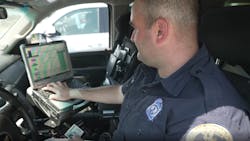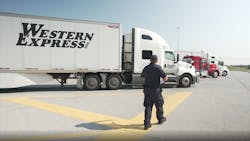How truckers can save time during a roadside inspection
Enforcement of the ELD mandate in trucking created an opportunity to streamline the roadside inspection process for truckers and law enforcement officers alike. Enter the electronic inspection.
In 2018, CVSA’s Level VIII inspection took effect and involves an entirely electronic examination without direct interaction with an enforcement officer. The inspection occurs at weigh stations electronically or wirelessly while the vehicle is in motion.
CVSA defines the Level VIII inspection as a fully electronic inspection that checks off the same criteria that a Level III driver credential and administrative inspection would check—GPS coordinates, appropriate driver's license class, valid medical certification, record of duty status, hours-of-service compliance, U.S. DOT number, operating authority, and federal out-of-service orders.
A few years ago, the technology wasn’t quite ready to handle these e-inspections, according to Sara Steele, product manager and director of compliance for Drivewyze. Now it is.
In June 2021, Drivewyze, a connected truck services provider and operator of the largest public-private weigh station bypass network in North America, announced open enrollment for its e-inspections pilot. Six states—Kansas, Maryland, Maine, New Hampshire, Virginia, and Utah—are piloting expedited in-station e-inspections at select weigh stations.Fleets subscribed to Drivewyze PreClear weigh station bypass service can request to participate in the e-inspection pilot project. During these expedited in-station inspections, officers will select a vehicle for inspection and have most of the administrative and driver data that is needed automatically transferred and validated and then automatically prefilled in their inspection reports.
See also: Roadside inspections: A necessary evil
“It saves time and improves accuracy,” Steele pointed out. “Drivers don’t have to manually send their logs from their ELD. That’s a step that can be scary for a driver. It might be a long time since they have done an inspection and had to transfer their logs. They might be working with a new company and a different ELD than they used in the past, so they never transferred logs on that device before."
“If drivers don’t hear the inspector code right or type in the information correctly, the inspector can’t find the logs and then could write up the driver for a noncompliant ELD,” she added.
Western Express, a fleet of 3,500 power units, began the Drivewyze e-inspection pilot in 2021. Daniel Patterson, Western Express director of safety, said since participating in the pilot, e-inspections have significantly cut down inspection times for drivers in those participating states.
“One of the biggest things we have done through Drivewyze is making sure the license information and everything we upload into the ELD is correct,” Patterson explained.
“We have a monitoring program for driver’s licenses, and we are heavily engaged in hours-of-service monitoring and best practices on the equipment,” Patterson added. “It’s difficult to look at all that equipment, but making sure our drivers are submitting pre-trips and post-trips every day, making sure that we have a preventive maintenance program that we invest heavily in, and making sure we get hands on our equipment has gone a long way.”Steele also pointed out that with more than 5 million commercial vehicles on the highways and only 13,000 enforcement officers inspecting them, expedited inspections can help law enforcement conduct inspections quicker and more accurately prefill their inspection reports.
The access to data, Steele said, is equipping inspection officers with the tools and more information to be more strategic in their enforcement. That could be particularly useful for targeting higher-risk areas where there are more violations of a certain type.
“There’s a spot in Colorado that is an open stretch of 130 miles of straight road, so they see a lot of fatigued driving and crashes in that area,” Steele said. “Officers started doing more HOS inspections through that area. So, is it the violations causing the trends or the enforcement and that strategic design causing the trends?”
See also: How to prepare for Roadcheck 2022
When it comes down to avoiding some of those higher-risk trends, Western Express requires that most of its drivers go through training with a mentor. Western Express hires many drivers that are new to the industry and new to commercial vehicles, so the carrier has focused training on what to expect and how to thoroughly prepare for a roadside inspection, Patterson noted.
Pre- and post-trips are also an essential part of the workflow at Western Express, and drivers are required to fill out their inspections through the ELDs at the beginning and end of each day.
“They submit that each morning for their pre-trip and each evening for their post-trip,” Patterson explained. “By doing those and making it part of the workflow, it makes drivers prepared for that inspection so if there are any issues, we can take care of them prior to it being a safety concern.”
Ultimately, taking care of problems before they become safety events or out-of-service violations that lead to unplanned downtime with a trailer full of freight is the ultimate goal. Keeping up with those pre- and post-trip inspections will also help the industry move the needle on some of those pesky OOS percentages every year.
Editor's note: This is the second part of a two-part series on roadside inspections. Read Part 1 here.
About the Author

Cristina Commendatore
Cristina Commendatore is a past FleetOwner editor-in-chief. She wrote for the publication from 2015 to 2023.


